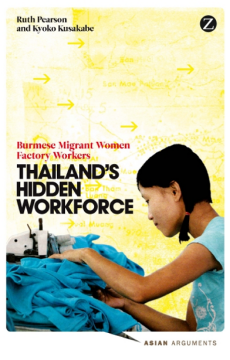
Additional Information
Book Details
Abstract
Millions of Burmese women migrate into Thailand each year to form the basis of the Thai agricultural and manufacturing workforce.
Un-documented and unregulated, this army of migrant workers constitutes the ultimate 'disposable' labour force, enduring gruelling working conditions and much aggression from the Thai police and immigration authorities. This insightful book ventures into a part of the global economy rarely witnessed by Western observers.
Based on unique empirical research, it provides the reader with a gendered account of the role of women migrant workers in Thailand's factories and interrogates the ways in which they manage their families and their futures.
Ruth Pearson is Professor of International Development at the University of Leeds, UK.
Kyoko Kusakabe is Associate Professor of Gender and Development Studies in the School of Environment, Resources and Development at the Asian Institute of Technology, Thailand.
'The authors give a voice to a part of Thailand's workforce invisible to many Thais, and to consumers across Asia and around the world who buy the cheap goods they produce. That voice is authentic, and paired with sound analysis of the issues raised.'
Chris Hogg, BBC Asia correspondent , Shanghai
'The labels on your clothes do not say 'Made by Burmese migrant women in Thailand', but once you have read this book you will carry that information with you. Many thanks to the authors for exposing these conditions.'
Jackie Pollock, director, MAP Foundation, Thailand
'This book reveals the hidden face of Thailand's industrial and migration policies by giving visibility and voice to Burmese female migrants employed in the country's ready-made garment and knitwear factories. The authors shine the spotlight, not only on the women's work experiences on the factory floor, but also on the way they juggle care responsibilities for their children. It is a compelling story about ordinary women making hard decisions under precarious conditions as they live transborder lives.'
Professor Brenda Yeoh, National University of Singapore
Table of Contents
| Section Title | Page | Action | Price |
|---|---|---|---|
| Asian Arguments | i | ||
| About the Authors | ii | ||
| Acknowledgements | vii | ||
| Map: Thailand and surrounding countries | viii | ||
| Abbreviations | ix | ||
| 1 Thailand’s hidden workforce: Burmese women factory workers | 1 | ||
| Burmese migrant workers in Thailand: hidden from the global gaze | 1 | ||
| The context: push-and-pull factors underlying Burmese migration to Thailand | 2 | ||
| Background to the research | 6 | ||
| Burmese women workers in Thailand: nimble fingers and docile bodies | 8 | ||
| Burmese migrant workers: citizenship and entitlement in a hostile world | 13 | ||
| Who cares? Burmese women in Thailand as carers and workers | 18 | ||
| Shifting terrain: Burmese migrant women’s responses to economic and political change | 20 | ||
| 2 Thailand’s industrialisation and labour migration policies | 22 | ||
| Thailand’s industrialisation before and after the Asian financial crisis of the 1990s | 22 | ||
| Decentralisation of industry | 25 | ||
| Demand for and control of migrant labour: regulating the irregular | 29 | ||
| Figure 2.1 Registered migrants 1997–2008 | 37 | ||
| 3 Burmese women migrant workers in Thailand’s export industries | 46 | ||
| The study areas | 48 | ||
| Figure 3.1 Apparel factories and workers in Tak province | 49 | ||
| Migrant women’s journeys | 56 | ||
| Reconstructing families | 66 | ||
| Remittances as obligation | 69 | ||
| Marriage, children and changing relationships | 72 | ||
| Women’s journeys: agency, subordination and change | 76 | ||
| 4 Migrant women in Thailand’s factories: working conditions, struggles and experiences | 77 | ||
| Who are the women workers? | 78 | ||
| What kind of factories do they work in? | 81 | ||
| Working conditions | 84 | ||
| Security of employment and mobility | 89 | ||
| Accommodation and food | 90 | ||
| Pay and deductions | 93 | ||
| Safety, security and harassment, deportation | 98 | ||
| Relations with friends | 101 | ||
| 5 Burmese migrant women and families in Thailand: reproduction, children and care | 106 | ||
| Pregnancy and childbirth | 107 | ||
| Table 5.1 Country of birth of first child by respondent’s location | 108 | ||
| Childcare | 114 | ||
| Table 5.2 Childcare patterns for children under 6 years old for those respondents who delivered a child after coming to Thailand, by location | 115 | ||
| Health care | 126 | ||
| Education | 128 | ||
| 6 After the crisis: new struggles and possibilities | 132 | ||
| Effect of the economic crisis on migrant workers’ employment in Thailand | 135 | ||
| Dealing with the crisis: coping strategies of migrant workers | 136 | ||
| Retrenchment and strikes | 139 | ||
| Harassment, xenophobia and prejudice | 151 | ||
| After the crisis — to stay or to return? | 155 | ||
| 7 Burmese migrant workers between two worlds | 165 | ||
| Appendix One History of registration exercises for irregular (temporary) migrant workers | 178 | ||
| Appendix Two Currency exchange rates: Thai baht/Burmese kyat/US dollar | 182 | ||
| Notes | 183 | ||
| Chapter 1 | 183 | ||
| Chapter 2 | 185 | ||
| Chapter 3 | 187 | ||
| Chapter 4 | 188 | ||
| Chapter 5 | 189 | ||
| Chapter 6 | 190 | ||
| Chapter 7 | 191 | ||
| References | 193 | ||
| Index | 199 | ||
| About Zed Books | 206 |
